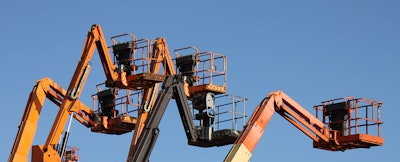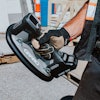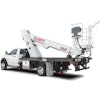
The use of aerial work platforms is on the rise. In a recent study, the International Powered Access Federation (IPAF) found that AWPs continue to grow as a percentage of rental fleets. This expanding user base is one of the concerns driving revised ANSI safety standards, as many operators are not highly experienced. The comment period for its new rules ends on May 16, and big changes are coming to the main industry-wide safety standard for AWPs, ENR reports.
“In these new standards, we’re looking at what we know today that we didn’t know when we wrote the last standard,” says Tony Groat, development manager at IPAF North America and an ANSI committee member. “We’re looking at new equipment in the marketplace, as well as new technology available to us.”
The proposed draft standards from IPAF and the Scaffold & Access Industry Association are A92.20 Design, Calculations, Safety Requirements and Test Methods for Mobile Elevating Work Platforms (MEWPs); A92.22 Safe Use of MEWPs; and A92.24 Training Requirements for the Use, Operation, Inspection, Testing and Maintenance of MEWPs. These will replace the existing A92.2, A92.22 and A92.24 standards.
Aerial work platforms, referred to in the new standard as “mobile elevating work platforms,” or MEWPs, have been reclassified in the new A92.2 as either vertical- or boom-based lifts. The categories now also include truck-mounted lifts, which were not addressed in the previous edition of the standard.
One of the biggest changes in the draft standard is the requirement for load-sensing alarms and cutouts to be built into new work platforms. “The load-sensing system in the current draft would be new to market,” says Brent Hoover, product safety manager at platform maker JLG. An audible alarm and a flashing red light will activate when a platform is overloaded, while a cutout engages to prevent further movement. A cutout also will trip when a tilt sensor goes off. “The tilt cutout is required when the MEWP is on a slope greater than the manufacturer says is acceptable,” says Hoover. “You can’t drive farther in the direction that put you on the slope.”
In addition to design changes, the new ANSI standards also will include new guidelines for operators, passengers and supervisors. Fall-protection gear will be required on all boom-type lifts, and the new standard will discourage the use of MEWPs to transport workers from one level to another. Further, it will be the supervisor’s responsibility to prepare a risk assessment for any use of the platform, placing the onus not just on the worker at the controls but also on site managers and contractors. “We define ‘supervisor’ as all personnel who directly supervise MEWPs,” says Frank
For more about revised standards for aerial work platforms...



















